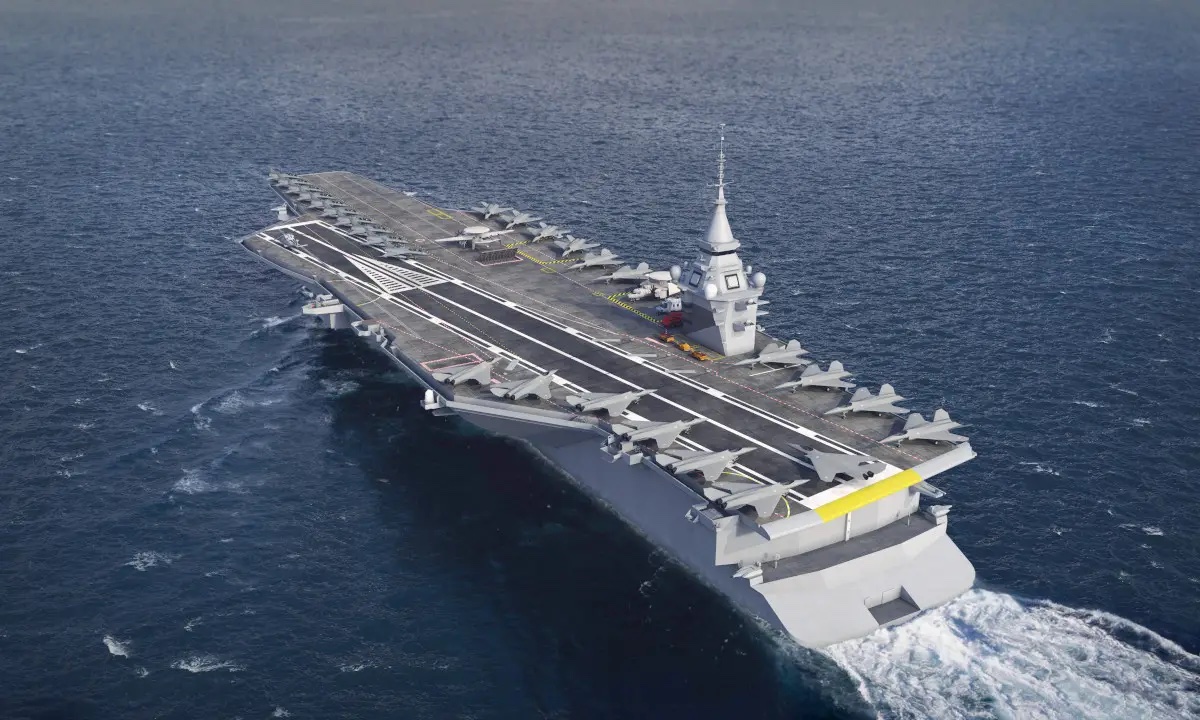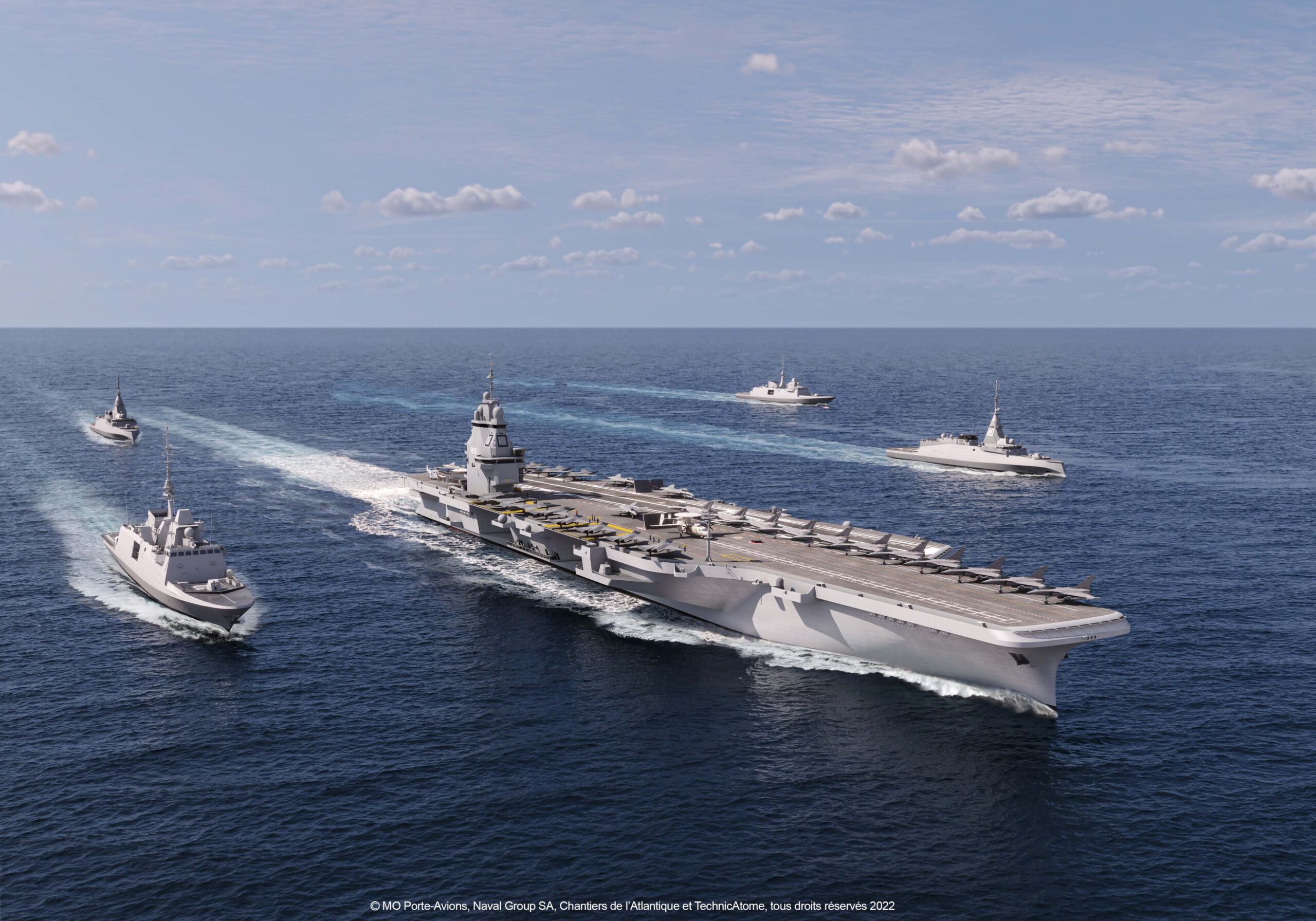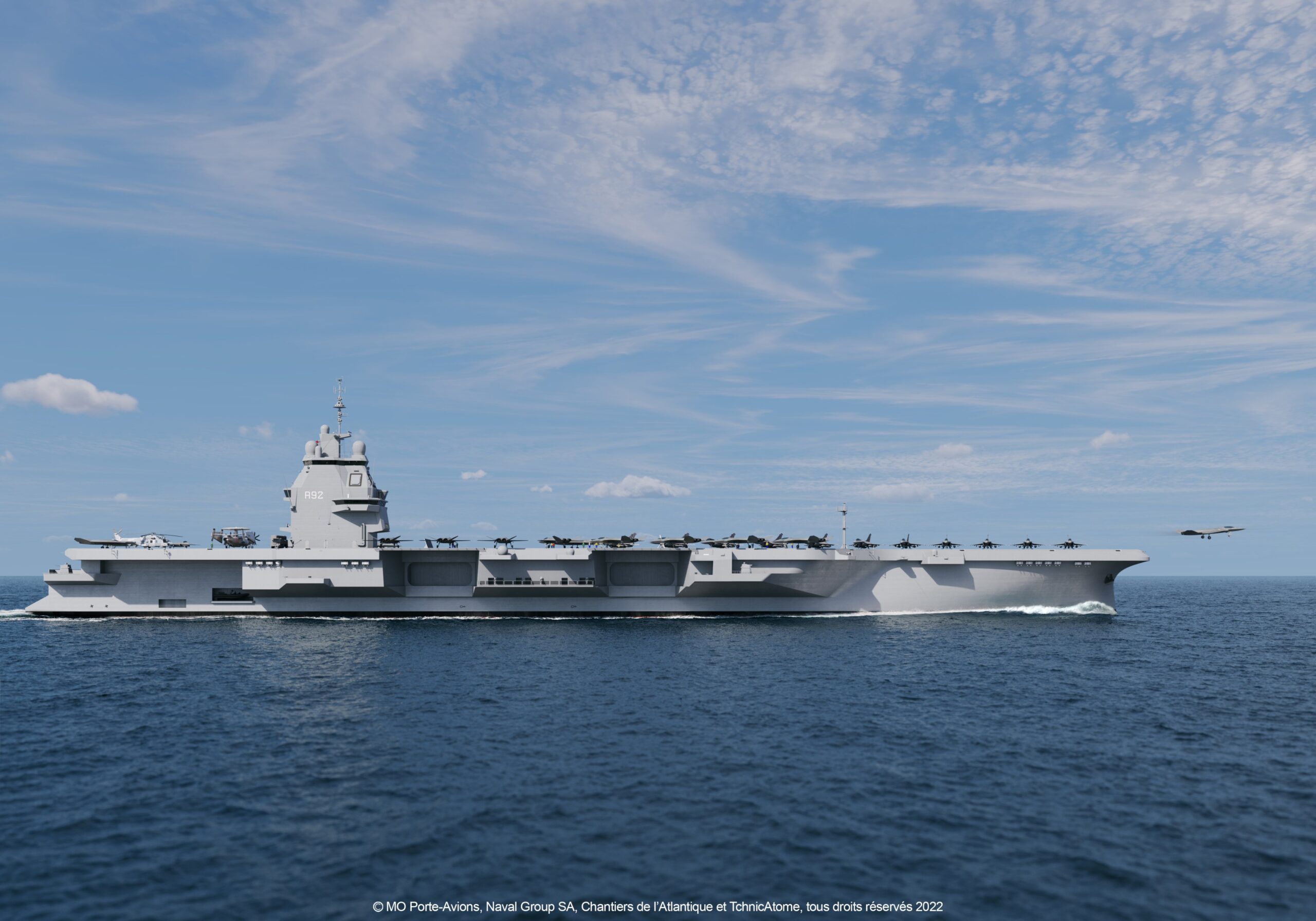Fresh renderings and a new model of France’s future nuclear-powered aircraft carrier, designed to replace the country’s existing flattop Charles de Gaulle, have been revealed by the partially state-owned French shipbuilder Naval Group. The new views of what is presently known as the “porte-avions de nouvelle génération,” or PA-Ng, (which translates to New Generation Aircraft Carrier) were shown off by the shipbuilder around the EuroNaval 2022 conference in Paris on October 18.
As The War Zone outlined in an earlier report on France’s future carrier, PA-Ng boasts a Catapult Assisted Take-Off Barrier Arrested Recovery (CATOBAR) type design, with an angled deck and a relatively small rear-set island superstructure that features flush-mounted active electronically scanned array (AESA) radar antennas. In fact, it looks like the small cousin of the U.S. Navy’s new Ford class in some ways. French President Emmanuel Macron announced his government had initiated a program to develop a new nuclear-powered carrier back in December 2020, and it is expected PA-Ng will replace Charles de Gaulle in 2038.
Several key differences in PA-Ng’s design are noticeable when comparing earlier renderings released by Naval Group and the French Ministry of Armed Forces in 2020 with the new renderings – which include a reworked design of the vessel’s island, alterations to the flight deck, and changes to the various sponsons on either side of the vessel.
Most notably, the shape and size of the carrier’s island appears to have been altered – changing from something of an elliptical shape to a more boxy, squared-off configuration. It’s also notable that the window arrangement has changed, and that the placement and configuration of the island’s domes have been altered. Although the four SeaFire radar panels, originally seen in the 2020 renderings, remain, the island’s ‘cone’ top has been replaced with a different setup that prominently features satellite communication domes.


The evolution of the vessel’s main island can be seen even more clearly when comparing Naval Group’s updated vessel model with an earlier model that was shown to President Macron in December 2020.
A new helicopter take-off and landing spot has also been added to the area behind PA-Ng’s island, alongside an aircraft maintenance zone.
Differences can also be recognized in the placement of various sponsons (side projections that provide utility extension for weapons and sensor placement, among other uses) in the original and updated concepts. Naval Group’s earlier rendering of the ship clearly shows two sponsons protruding towards the vessel’s bow, which appear to support Rheinmetall Oerlikon Millennium Gun close-in weapon systems, among other radomes. In the updated design, however, these sponsons have been relocated, with the close-in weapon systems having been pushed further back.
It’s also worth noting that the new renderings and model give a clearer picture as to how many aircraft the carrier might be able to accommodate in parked positions on its deck. In the earlier 2020 renderings, two separate designs show the carrier’s right-hand edge supporting a different number of aircraft parking spaces in front of the island – one with 10, and one with 8. The 2022 renderings and model both show the carrier’s right-hand edge supporting 8 parking spaces, indicating that, for now at least, Naval Group has settled on a total of 8 parking spots on that side.



The overall shape of the flight deck has also been altered slightly. According to Xavier Vavasseur at Naval News, this change was made to accommodate a third Electromagnetic Aircraft Launch System (EMALS) on the carrier, if desired. PA-Ng’s EMALS, which we discussed in detail in our previous report, will be provided by General Atomics.
The latest specifications on PA-Ng, which were shared before the start of EuroNaval 2022 by the Direction générale de l’armement (DGA), the French government’s defense procurement and technology agency, indicate that the carrier will run an overall length of 310 m/1,017.06 ft, and displace approximately 82,500 tons. Charles de Gaulle, in comparison, is around 858 ft, and displaces just 42,500 metric tons. Two K22 nuclear reactors, delivered by TechnicAtome, will drive the ship’s propulsion system and propel the vessel to speeds of up to 30 knots (more than Charles de Gaulle) as well as supply electrical power for the ship’s various systems. Moreover, Naval News highlights that the DGA is still supposedly weighing a number of options for the carrier’s weapons and sensor systems, with nothing yet “set in stone.”
PA-Ng is expected to have a crew size of around 2,000. According to Olivier de Saint-Julien, President of MO Porte-Avions (MO Porte-Avions is a joint venture between Naval Group and Chantiers de l’Atlantique, and is in charge of overall project management on the PA-Ng program), some of the crew will be aircraft engineers. Christina Mackenzie from Breaking Defense quotes de Saint-Julien saying this is because the French Navy “wants to be able to undertake the sorts of repairs on-board that normally would be done by the manufacturer.” According to the latest figures, PA-Ng’s aircraft engineers will service the carrier’s fleet of roughly 30 New Generation Fighters (NGF) and Dassault Rafale M jets. The vessel will also carry E-2D Advanced Hawkeyes and various other unmanned aircraft.

If the carrier’s program schedule is anything to go by, it’s possible that further changes to PA-Ng’s design could be implemented during the next few years, with the likelihood of further adaptations in the long term, too.
The carrier’s preliminary design studies phase is not set to end before the first quarter of 2023. Moreover, according to Breaking Defense, de Saint-Julien claims PA-Ng’s design won’t be fixed until 2025. A decision on launching the development and production phase is slated to occur in late-2025/early-2026 – when triggered, this period will run from 2026–2036.
De Saint-Julien also indicates that the final design will be able to accommodate newer technologies in the future, as Breaking Defense notes:
“It’s going to be designed in such a way that it can be modernized incrementally and the combat system can evolve … we don’t know today what kind of technology will be available in 15 years time so we need to allow for new technology to be able to be easily fitted,” de Saint-Julien claims.
The ship is expected to be built at Chantiers de l’Atlantique’s dry dock in Saint Nazaire, on the west coast of France. The carrier’s first sea trials are anticipated to take place in late 2035 or early 2036, with delivery at the end of 2036/early 2037. PA-Ng is expected to enter service at the end of 2037 or early 2038, at which time the Charles De Gaulle will be retired from service.
Whether or not MO Porte-Avions will be able to keep to this schedule, the development of the PA-Ng is significant for France and its Navy. France and the U.S. are the only countries in the world whose navies operate CATOBAR, nuclear-powered aircraft carriers.
Anticipating the carrier’s future role within NATO/allied operations certainly indicates that the French authorities remain committed to advancing the project, and the French Navy’s carrier capabilities, over the coming decades.
Contact the author: oliver@thewarzone.com
